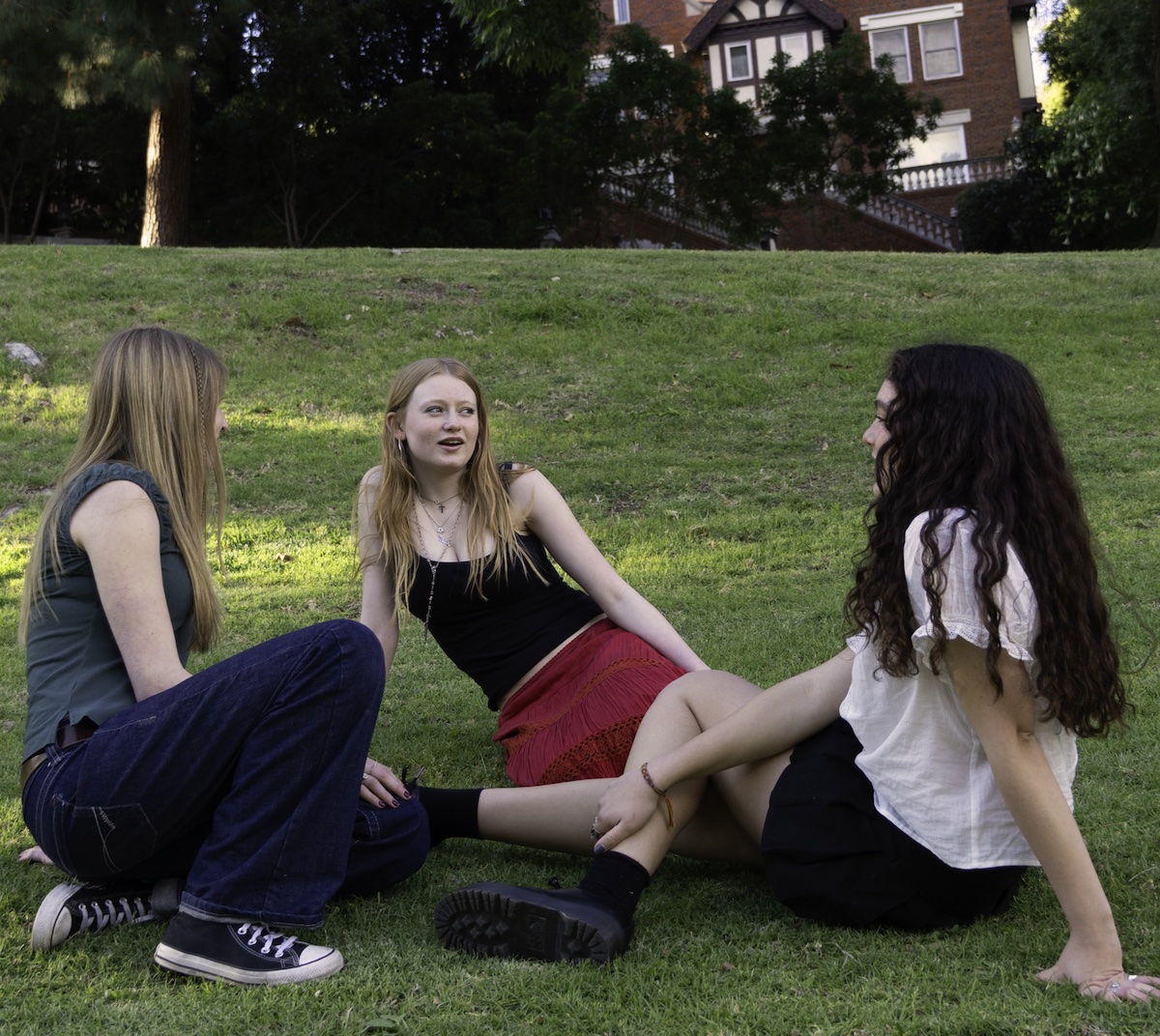Olivia ‘14 turns on her computer to start her homework for her Geometry class. She goes to the website, finds the correct lesson and watches a 20 minute video about the distance formula. The next day in class, she will work on textbook problems in groups and can ask her teacher questions on whatever she does not understand.
These videos are part of Mathematics Department Head Chris Talone’s attempt at merging technology and learning. Students use the videos to learn the material on their own, swapping the conventional approach of instructing in class and practicing at home.
Mathematics instructor Amanda Kissinger tried a similar technological experiment with her Algebra classes this year. Every day, only one student was allowed to take notes. That evening, while the rest of the class worked on problems from the textbook, the student who took notes produced a video tutorial about the lesson, uploading it to the Internet for the rest of the class to learn from.
Kissinger said that she believed the student producing the video would better understand the lesson by having to teach the material back to the class.
One of these experiments has proven effective in teaching students new material. The other has not.
PLANNING FOR THE FUTURE
The Geometry instructional videos and student-produced videos in Algebra II with Trigonometry are only two of the many new technological advances implemented around the school at the start of the 2010-2011 school year. Others include the class website tool Haiku Learning Management System (LMS) and school-based e-mail accounts for all students.
Most of the inspiration behind these new advances came from speeches delivered to the faculty and a select group of students last fall by Alan November, a noted futurist and educational consultant. The speeches focused on the idea that faculty should encourage students to apply academic concepts through technology. He also spoke of having students learn material online for homework and work on problems in class—a concept that inspired Talone in developing his new Geometry class.
The main question facing Marlborough as the school increases the amount of technology students use in the classroom and at home is one of efficiency. While most students and faculty think the influx of new technology is helpful, some said they believe that these implementations were not necessary. According to the numerous students and faculty members interviewed for this article, while it is important to integrate technology into the curriculum, it is more important to avoid wasting learning time with inefficient or confusing technologies.
ADJUSTING TO CHANGES
According to many faculty members, introducing a new technology usually comes with a period of difficulty when people learn how to best use the new tool. Marlborough has experienced some growing pains in the past month as students and teachers alike learn how to efficiently use Haiku, their new e-mail accounts and other new technologies.
Geometry student Symone ’14 said there were some minor adjustment problems with the new technology in class, but over time she got used to it.
“At first I thought the videos wouldn’t teach us to the full extent and we would have a lot of questions in class, but it seems to be working,” Symone said.
Algebra II students like Janette ’13 sang a different tune.
“I personally like taking notes so I didn’t like the idea,” Janette said. “I feel that I can understand if I have it written down so I can refer to it later.”
Algebra II with Trigonometry student Eva’13 said that while producing the video was fine, it took her about two hours to figure out how to upload it to the Internet. She said that regardless of the technological challenge, she did feel that she learned the material better because she needed to fully understand it to teach it.
Kissinger acknowledged that not every student was comfortable with the video plan at first, but she said she hoped over time the students would be able to get used to it. When a student survey three weeks into school revealed that the students were not watching the videos, largely because they were being posted at inconsistent times, Kissinger decided to make a change.
“We didn’t want to use technology just to use it. We want it to be effective,” Kissinger said.
The technology was supposed to make learning more efficient, and since the videos didn’t achieve this, they were eliminated.
Talone said that part of the reason why the videos didn’t work was because telling students to not take notes in class was too big of a cultural change.
While Janette is pleased to able to take notes again, Cassidy ’13 has mixed feelings about the new change.
“I like having at least some problems that I can look back on for tests and quizzes, but I also did like the videos because I could process what she was writing on the board more as opposed to when I was writing it down. It was nice to have a little bit of both,” Cassidy said.
ONLINE COMMUNICATION
Another tool being used by teachers this year is the Haiku Learning Management System (commonly referred to as “Haiku”). Haiku is a website that allows faculty to upload videos, assignments and class information for students to access online. The website also provides a potential forum for online class discussions, submitting work and taking assessments.
According to Stuart Posin, Director of Academic and Administrative Technology, about half of the faculty members have web pages for their classes through Haiku. The other half still have a page on the Marlborough portal.
Most students and teachers seem to find Haiku useful, but some still have issues with the divide between Haiku and the school portal. While the faculty was invited to attend workshops on how to use Haiku over the summer, not all attended.
Many faculty members are still unfamiliar with the website and have kept their assignments on the school portal. This poses difficulties for some students like Jenny ’15, who has to check both sites for assignments.
“The point of Haiku was to make things easier, so I’d like it if we either stick to the portal or move completely to Haiku,” Jenny said.
In addition to checking the portal and Haiku, some students are required by their teachers to check and use their Marlborough e-mail accounts, created this year. These email accounts have created additional confusion among students and faculty, as not all faculty members enforce the use of Marlborough e-mails.
English Instructor Susan Cope said that as long as she knows who sent the e-mail, she’s fine with her students e-mailing her from either their personal or school account. But for some teachers, the inconsistency in enforcement can be frustrating because it encourages students to ignore their Marlborough accounts.
“The girls, particularly in the younger grades, need to get in the habit of using a professional Marlborough e-mail,” said French instructor Elizabeth Vitanza.
Hannah ’12 said that some of her classmates dislike having to check the Marlborough e-mail along with their own personal one, but she said she managed to bypass this confusion by forwarding her Marlborough mail to her personal account.
“It’s nice to have everything in one place as opposed to being told there’s something somewhere and having to check several websites,” Hannah said.
Although some are finding it difficult to adjust to their new e-mail addresses, others, including Olivia’16, enjoy having an account specifically for school-related updates.
“I go on every day. It’s very important to me because I get e-mails and figure out what my homework is. I think it helps a lot too,” Olivia said.
MORE CHANGES TO COME?
Regardless of whether the school implements more technology, students and faculty agree that the most important aspect is how it’s put to use.
Talone said that he was ready to switch back to his traditional teaching style if the change in his Geometry classes didn’t work.
“Anything that doesn’t move student learning forward I would ditch for something that does move student learning forward,” Talone said.
Other students and teachers said they hoped the school would implement technology purposefully into the classroom in the coming years.
Jenny ’15 said that Haiku in particular needs to be used wisely in order to justify its existence.
“You don’t really learn things by opening a document,” she said.
New technologies are being introduced every day. From 3-D projectors to instructional online video databases Atomic Learning and Discovery Education, the student learning experience at Marlborough may change dramatically in the years to come.
“Changing technology is good if it makes our lives easier. We don’t need to change for the sake of changing,” said science instructor Lisa Ellis.
Article by Caroline ’12, Ileana ’12






